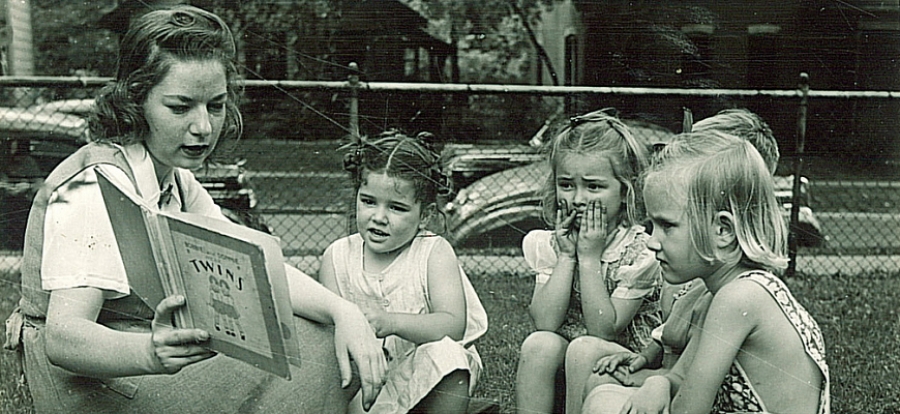Story Stones
In Pullman’s His Dark Materials Trilogy, Lyra was able to recreate the stories interpreting the symbols on the Alethiometer…
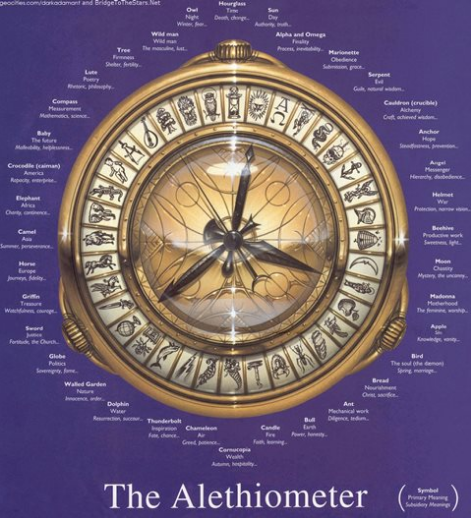
Story Stones are fantastically simple resource, which use symbolism, to use inside and out!
It is very easy to create your own or allow the children create their own. With younger children you might consider creating a set of stones to retell a class story, such as The Gruffalo or Where the Wild Things Are. These stones can be hidden around a garden, field or outdoor space and the children can sort, organize and rearrange them to either retell or restructure the story.
With older children, they can create their own stones and stories. This can be a highly engaging way to develop a culture of oral storytelling. Those stories can quickly be developed deeper and converted into written stories.

Story Walks & Imagined Worlds
Use the playground to create really large scale story maps.
Children of any age can use this planning method to create the worlds in which they can either retell, modify or create stories. They can add details, descriptions, vocabulary or whatever else they need to form and sequence their narratives. The added bonus is that once the map is drawn it allows the children to play ‘within’ their story and outside the lesson. The true power comes when they can invite other children into the story and continue to build it.
These examples are from: www.holmprimary.co.uk/paddington-p23
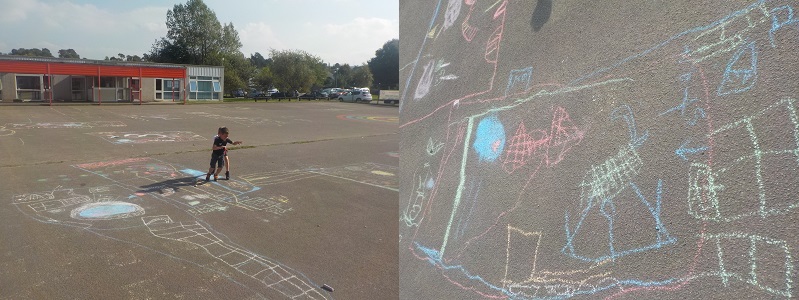
“If a child has nothing to say, then they will have nothing to write!”

If it is good enough for Grampy Rabbit, then it is good enough for me!
In one instance, my class were struggling to image a journey across an unfamiliar landscape, I took them out to make it happen. At first they just went through the motions, but by building a clear and shared narrative with them, they were soon holding on, trying not to fall off the mountain pass, even retracing their steps to help each other, adding more and more to their world.
Once back inside we could retell the story and build ideas together. The room positively buzzed as they developed more and more detail and remembered more and more of their adventure - the writing they produced was some of the best of the year.
Instant Maths Ideas…
We have all done calculations in exercise books, on paper, on whiteboards, but have you, I wonder, considered the benefits of completing calculations on the playground? It's a different experience to working on paper.
‘Big working’ makes it easier to work together and allows children to experiment and explore. Whether or not the children are completing written methods of addition, subtraction, multiplication or division, or if they are simply writing out multiplication tables or addition bonds to 20, there is a semi-permanent record of the work. The conversations of other children at playtime about the work is also worth listening to!
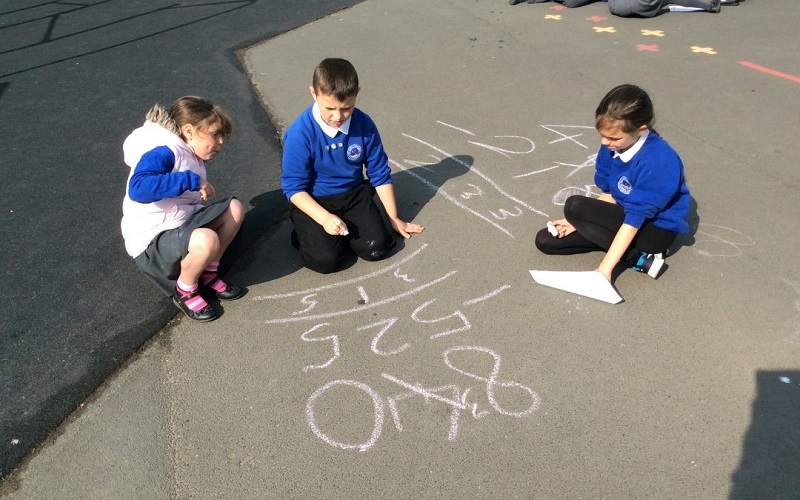
http://felldykeprimary.org/blog/category/year-4/page/2
Once again, the activity you complete with your class has the potential to impact on the learning of pupils beyond your class.
Bricks and Hopscotch
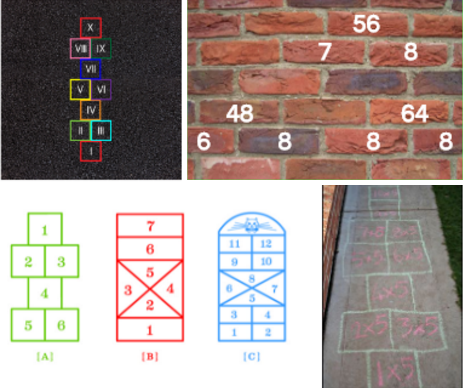
Hopscotch is a great gateway into so much Mathematics. Using hopscotch games to learn multiplication tables, chant the table as you play…
Creating a regular hopscotch game but substituting Roman Numerals instead of the traditional characters/digits makes for an interesting adaptation.
Similarly, change the hopscotch boxes into equivalent fractions. Anything that can be done to create a game to support the in-class learning, that can be done outside, before or after school and at break and lunch times gives a continuity of learning that can be as tangible as it is powerful. Rest assured; if it is there, children WILL use it.
Write the products of multiplication tables on bricks with the multipliers below and you’ve created the multiplication/division trios. The fact that these are written and recorded beyond the classroom mean they impact every child! I completed this task with a group of Y4 children and they were being quizzed on it by a couple of Y2 boys. Those same boys the following day were able to tell me, “Mr W., 8 x 7 is 56, and 6 x 7 is 42”. They knew because it was there for them to see and they remembered.
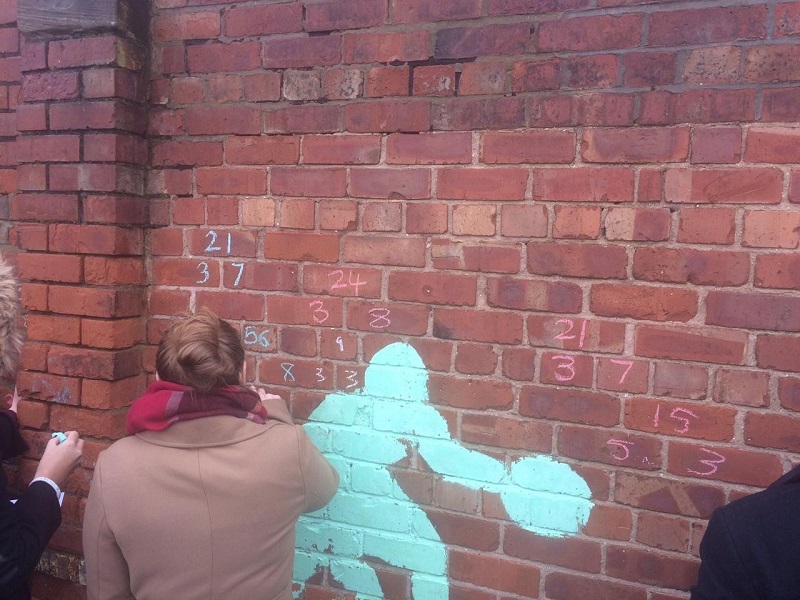
More Quick Maths ideas:
Algebra with Objects
Substitute known objects, leaves, conkers, flowers etc for x or n, and eliminate that “now there are letters in my simple missing number problems I don’t understand” issue. If 2 conkers + 2 = 6, what is the value of a conker? (2)
‘Multiplication fact trails’ made by hanging QR Code / AR questions / Leaves and answers up around the ground offers an alternative to class activities.
Do you have a patio area, or an area of paving slabs? This can be used to create either data handling activities, carroll diagrams and graphs, or coordinate grids. If you can hand a tarpaulin or sheet across the middle you can play coordinate battleships.
PhotoBooth Symmetry
The Photobooth App has lots of fun outdoor applications, that can be applied in all manner of subject contexts.
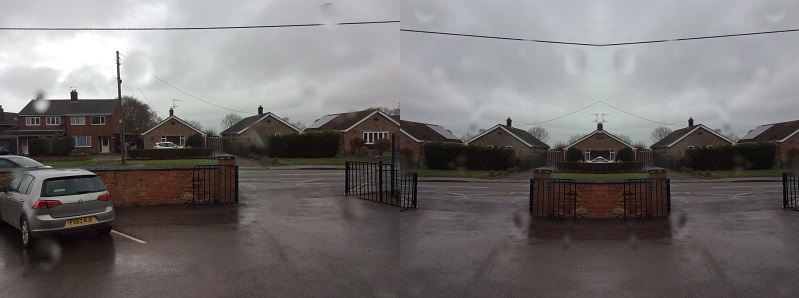
Can the children explain why the house looks the same yet the carpark is completely different?
It is a really high-quality way to get the children using the language of symmetry. Explaining their reasoning all along the process.
- Can you collect images with a single axis of symmetry? What things work well? Less well?
- Can you make an image overlap itself?
- Can you make an image seem normal, ie not a reflection? What properties does it need?
- Collect, Present and Share these images using ‘Moldiv’ or ‘PicCollage’
I especially enjoy playing ‘Real or No Real!’ with the images either I create or the children create. Can they work out what photographs are genuine?
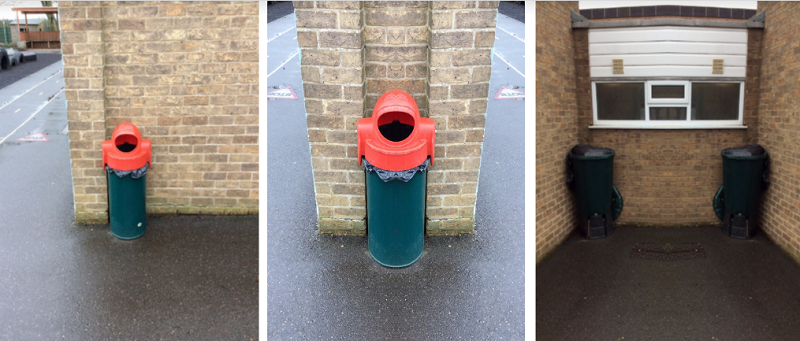
The middle image caused so many arguments between my class, as the bin looked real, but they couldn’t work out where the wall was. It fell to an eagle-eyed Y3 who realised the symmetry in the playground markings.
Grafitti Learning
This is a really easy activity to adapt and change to suit your approaches, needs and aims. I have trialled this a few times before and it works well. #Graffitilearning is a simple idea children really enjoy, perhaps because they can perceive it as something a bit 'naughty'.
The premise is simple.
You need a wall (one that people can see including parents/families), some chalk, a waterproof tub and the optional use of one of my favourite outdoor learning resources: Blackboard Paint.
Choose your wall, paint it with the blackboard paint if you wish, put out the chalks in the watertight container, explain the protocols and practices to the children and you are ready!
This wall is for sharing learning and nothing more.
Did Y6 crack fraction by fraction division? They can write how and give an example.
Did Y3 crack the placement of fronted adverbial phrases? Write one and underline it.
Have your class been learning a British History timeline? They can draw it here.
"Mr W., I know Roman Numerals now..." Write them on the wall.
The children just name and date their graffiti. Everyone gets to see what they are learning, children can critique and discuss things that are there. I've seen great debates over written methods in Maths!
I have not only encouraged children to share vocabulary like a glossary, mathematical methods, key facts, but also labelled diagrams, flow charts and lists. And that's it…
The information on the wall grows over the week or the half term, it tends to clean itself with a bit of weather. If not, you just need a child and a bucket of water!
Other members of the school community can have a hand in it too. Teachers, governors, siblings and parents can note comments (positive preferably), corrections and questions on the wall and suddenly everyone is involved in the learning.
It should be a free access space that all children are entitled to use. I have never yet had issues with children being anything other than respectful of each other's work. Infact seeing someone in Y5 help a Y1 with their spelling can be nothing but a positive action for everyone.
It could be focused on a particular subject area or theme as your school priorities dictate. Are you having issues with SPaG or focused on Multiplication Tables? Need everyone to see what you are doing about it? #graffitilearning
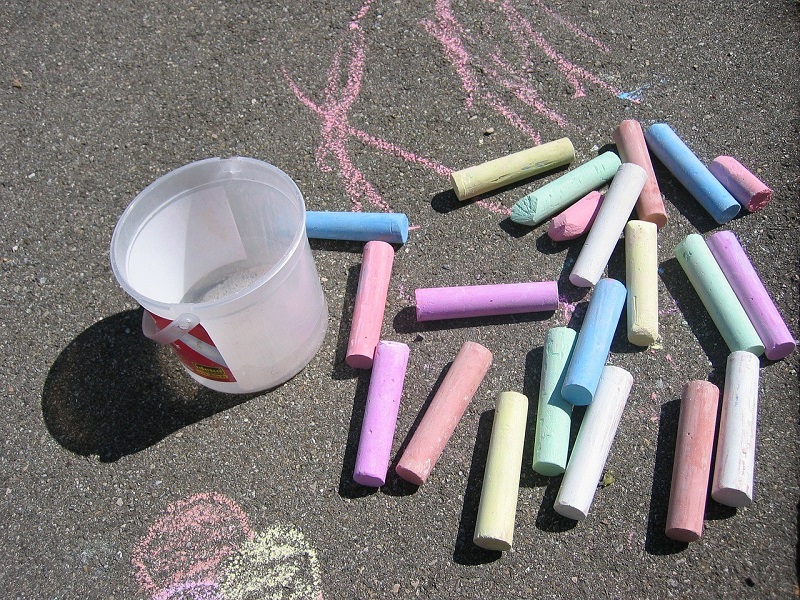
There are so many ways that a class teacher can enhance and vary their teaching through allowing children to work and learn outside the classroom. Learning is always paramount, however if you can find a new and different way to present the learning experience, it is possible to improve outcomes for not only the children under your direct care but to those in other classes, year groups and phases.
When it comes to showing progression across the school, perhaps the writing really is on the wall (and floor...!)
How do you get pupils learning outdoors? Let us know below.


